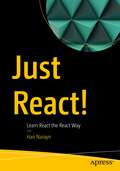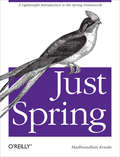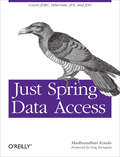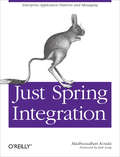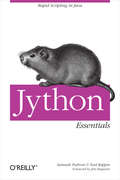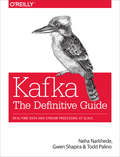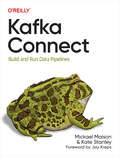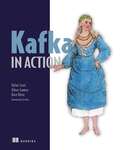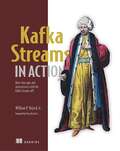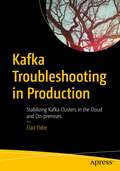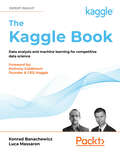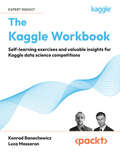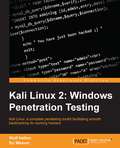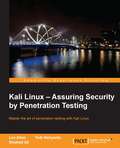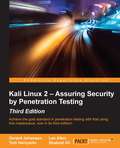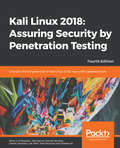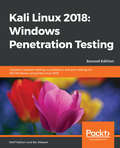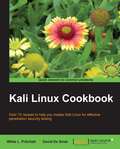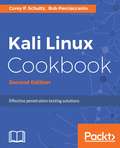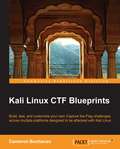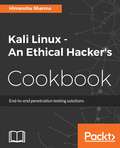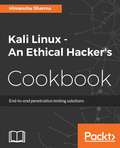- Table View
- List View
Just Peachy: Comics About Depression, Anxiety, Love, and Finding the Humor in Being Sad
by Holly Chisholm"In this autobiographical collection of thoughtful and poignant comic vignettes, Chisholm explores her experiences with depression, anxiety, and love ." —BooklistJust Peachy is a comic series that explores what the day-to-day is like with depression and/or anxiety. The all-too-real cartoon protagonist gives readers a character to empathize with, and helps explain some of the not often talked about consequences and symptoms of having depression. The comics also explore the themes of heartbreak, finding love, dealing with stress, and capturing the magical moments in life that keep us going.Through dark humor and cute illustrations, the subject matter becomes a bit more bearable, allowing for honest discussion about things like treatment and getting through anxiety attacks, and providing some comfort in times of struggle.For anyone affected by mental illness, Just Peachy shows that you are not alone. Simply put, this is an encouraging collection of comics about being just okay sometimes.&“So brave of Holly Chisholm to share her struggles with mental health issues through this creative medium. Just Peachy will inspire others to connect to, navigate through, and recover from their own day-to-day trials and tribulations of living with a mental illness. Well done!&” —Dr. Carlin Barnes and Dr. Marketa Wills, authors of Understanding Mental Illness and founders of Healthy Mind MDs
Just React!: Learn React the React Way
by Hari NaraynHere is your perfect companion for learning about and developing React applications. This book introduces concepts innovatively, using real-world examples based on the most recommended practices to help you establish a firm foundation. This comprehensive approach provides a strong focus on building components by using React hooks. You’ll begin by learning web fundamentals, next-generation JavaScript, and how React fits into this. In the chapters that follow, you’ll build a React application from scratch and learn about JSX, components, props, state management, prop drilling, context, and lifecycle events. Along the way you’ll build a multi-component app and see how the components interact. Debugging and styling React applications are also discussed. You’ll then take an in depth look at React hooks and see how to create a custom hook. There is also a penultimate chapter that explores important concepts such as routing and authentication. The book concludes with a review of some exciting features in the upcoming release of React 18. After reading Just React you will be equipped with the skills necessary to build complex web and mobile user interfaces using this flexible JavaScript library.What You’ll LearnExamine the details of modern React concepts through example projectsSet up your own React projectDebug and style React componentsTake a look at routing, authentication, HTTP requests, Redux, and the new features of React 18 Who This Book Is For Web developers, React developers, and JavaScript developers
Just Spring: A Lightweight Introduction to the Spring Framework (Oreilly And Associate Ser.)
by Madhusudhan KondaGet a concise introduction to Spring, the increasingly popular open source framework for building lightweight enterprise applications on the Java platform. This example-driven book for Java developers delves into the framework's basic features, as well as advanced concepts such as containers. You'll learn how Spring makes Java Messaging Service easier to work with, and how its support for Hibernate helps you work with data persistence and retrieval. Throughout Just Spring, you'll get your hands deep into sample code, beginning with a problem that illustrates dependency injection, Spring's core principle. In the chapters that follow, author Madhusudhan Konda walks you through features that underlie the solution. Learn dependency injection through a simple object coupling problem, along with different injection types Tackle the framework's core fundamentals, including beans and bean factories Dive into containers and other advanced concepts, such as event handling and autowiring beans Discover how Spring makes the Java Messaging Service API easier to use Learn how Spring has revolutionized data access with Java DataBase Connectivity (JDBC) Use Spring with the Hibernate framework to manipulate data as objects
Just Spring Data Access
by Madhusudhan KondaJDBC has simplified database access in Java applications, but a few nagging wrinkles remain--namely, persisting Java objects to relational databases. With this book, you'll learn how the Spring Framework makes that job incredibly easy with dependency injection, template classes, and object-relational-mapping (ORM). Through sample code, you'll discover how Spring streamlines the use of JDBC and ORM tools such as Hibernate, the Java Persistence API (JPA), and Java Data Objects (JDO). If you're a Java developer familiar with Spring (perhaps through O'Reilly's Just Spring tutorial) and want to advance your data access skills, this book shows you how. Learn how to use Spring's basic and advanced data access tools Work with Spring's JdbcTemplate class to separate non-critical code from business code Eliminate placeholder variables in your queries with the NamedParameterJdbcTemplate class Use Spring's template classes to perform batch executions Operate inserts on database tables without writing any SQL statements Learn about Spring's support for Hibernate as an object-relational-mapping tool Use JPA as a standards-based ORM--alone or with Spring support Move data from a relational to a non-relational database with JDO
Just Spring Integration
by Madhusudhan KondaGet started with Spring Integration, the lightweight Java-based framework that makes designing and developing message-oriented architectures a breeze. Through numerous examples, you'll learn how to use this open source framework's basic building blocks to work with both inter- and intra-application programming models. If you're a Java developer familiar with the Spring framework (perhaps through O'Reilly's Just Spring tutorial) and want to advance your skills with Enterprise Application Integration (EAI) patterns, and messaging systems in particular, this book is ideal. Learn Spring Integration fundamentals, including channels, endpoints, and messages Use message channels to decouple applications, separating producers from consumers Discover how common endpoint patterns separate a messaging application's business logic from integration details Create a seamless integration between the endpoints, using Transformers Implement Spring Integration's flow components to design your messaging application's business flow Configure the framework's File, FTP, JMS, and JDBC adapters to integrate with external systems
JXTATM in a Nutshell
by Li Gong Scott Oaks Bernard TraversatO'Reilly's pioneering reference is the first and last word on this powerful distributed computing technology. JXTA in a Nutshell delivers all the information you need to get started, including an overview of P2P distributed computing, an explanation of the JXTA Project's new platform, and ways that developers can become a part of the development effort. JXTA in a Nutshell introduces major concepts in a hands-on way by explaining them in context to the shell, and contains a complete reference to the JXTA app
Jython Essentials
by Samuele Pedroni Noel RappinJython is an implementation of the Python programming language written in 100% pure Java, so it runs under any compliant Java Virtual Machine. The secret to Jython's popularity lies in the combination of Java's libraries and tools with Python's rapid development capabilities. With Jython, you can write Python programs that integrate seamlessly with any Java code. And like Python, Jython can be used interactively, so you can get immediate results as you are programming. Jython Essentials provides a solid introduction to the Python language, offering a brief but thorough tour of the Python concepts you'll need to understand to use Jython effectively. The book makes frequent comparisons between Python and Java, with special emphasis on the different object-oriented semantics of the two languages, so Java programmers can quickly get up to speed with Jython. Jython Essentials also covers the various ways in which Jython and Java can interact. For example, Jython code can create instances of pre-existing Java classes and call methods in those instances. You can write Jython classes that are direct subclasses of existing Java classes and use introspection to discern the capabilities of JavaBeans components. This book provides examples of using Jython with existing Java libraries, including the Swing GUI toolkit, the JDBC database API, the Servlet API, and various XML tools. And finally, the book shows how Jython can be used as a scripting language within a Java program. With Jython Essentials, you have everything you need to start creating applications that mix the best of Python's interactivity and Java's robust libraries.
Kafka: Real-Time Data and Stream Processing at Scale
by Gwen Shapira Neha Narkhede Todd PalinoEvery enterprise application creates data, whether it’s log messages, metrics, user activity, outgoing messages, or something else. And how to move all of this data becomes nearly as important as the data itself. If you’re an application architect, developer, or production engineer new to Apache Kafka, this practical guide shows you how to use this open source streaming platform to handle real-time data feeds.Engineers from Confluent and LinkedIn who are responsible for developing Kafka explain how to deploy production Kafka clusters, write reliable event-driven microservices, and build scalable stream-processing applications with this platform. Through detailed examples, you’ll learn Kafka’s design principles, reliability guarantees, key APIs, and architecture details, including the replication protocol, the controller, and the storage layer.Understand publish-subscribe messaging and how it fits in the big data ecosystem.Explore Kafka producers and consumers for writing and reading messagesUnderstand Kafka patterns and use-case requirements to ensure reliable data deliveryGet best practices for building data pipelines and applications with KafkaManage Kafka in production, and learn to perform monitoring, tuning, and maintenance tasksLearn the most critical metrics among Kafka’s operational measurementsExplore how Kafka’s stream delivery capabilities make it a perfect source for stream processing systems
Kafka Connect
by Mickael Maison Kate StanleyUsed by more than 80% of Fortune 100 companies, Apache Kafka has become the de facto event streaming platform. Kafka Connect is a key component of Kafka that lets you flow data between your existing systems and Kafka to process data in real time.With this practical guide, authors Mickael Maison and Kate Stanley show data engineers, site reliability engineers, and application developers how to build data pipelines between Kafka clusters and a variety of data sources and sinks. Kafka Connect allows you to quickly adopt Kafka by tapping into existing data and enabling many advanced use cases. No matter where you are in your event streaming journey, Kafka Connect is the ideal tool for building a modern data pipeline.Learn Kafka Connect's capabilities, main concepts, and terminologyDesign data and event streaming pipelines that use Kafka ConnectConfigure and operate Kafka Connect environments at scaleDeploy secured and highly available Kafka Connect clustersBuild sink and source connectors and single message transforms and converters
Kafka in Action (In Action Ser.)
by Dylan Scott Viktor Gamov Dave KleinMaster the wicked-fast Apache Kafka streaming platform through hands-on examples and real-world projects.In Kafka in Action you will learn: Understanding Apache Kafka concepts Setting up and executing basic ETL tasks using Kafka Connect Using Kafka as part of a large data project team Performing administrative tasks Producing and consuming event streams Working with Kafka from Java applications Implementing Kafka as a message queue Kafka in Action is a fast-paced introduction to every aspect of working with Apache Kafka. Starting with an overview of Kafka's core concepts, you'll immediately learn how to set up and execute basic data movement tasks and how to produce and consume streams of events. Advancing quickly, you&’ll soon be ready to use Kafka in your day-to-day workflow, and start digging into even more advanced Kafka topics. About the technology Think of Apache Kafka as a high performance software bus that facilitates event streaming, logging, analytics, and other data pipeline tasks. With Kafka, you can easily build features like operational data monitoring and large-scale event processing into both large and small-scale applications. About the book Kafka in Action introduces the core features of Kafka, along with relevant examples of how to use it in real applications. In it, you&’ll explore the most common use cases such as logging and managing streaming data. When you&’re done, you&’ll be ready to handle both basic developer- and admin-based tasks in a Kafka-focused team. What's inside Kafka as an event streaming platform Kafka producers and consumers from Java applications Kafka as part of a large data project About the reader For intermediate Java developers or data engineers. No prior knowledge of Kafka required. About the author Dylan Scott is a software developer in the insurance industry. Viktor Gamov is a Kafka-focused developer advocate. At Confluent, Dave Klein helps developers, teams, and enterprises harness the power of event streaming with Apache Kafka. Table of Contents PART 1 GETTING STARTED 1 Introduction to Kafka 2 Getting to know Kafka PART 2 APPLYING KAFK 3 Designing a Kafka project 4 Producers: Sourcing data 5 Consumers: Unlocking data 6 Brokers 7 Topics and partitions 8 Kafka storage 9 Management: Tools and logging PART 3 GOING FURTHER 10 Protecting Kafka 11 Schema registry 12 Stream processing with Kafka Streams and ksqlDB
Kafka Streams in Action: Real-time apps and microservices with the Kafka Streams API
by Bill BejeckSummaryKafka Streams in Action teaches you everything you need to know to implement stream processing on data flowing into your Kafka platform, allowing you to focus on getting more from your data without sacrificing time or effort.Foreword by Neha Narkhede, Cocreator of Apache KafkaPurchase of the print book includes a free eBook in PDF, Kindle, and ePub formats from Manning Publications.About the TechnologyNot all stream-based applications require a dedicated processing cluster. The lightweight Kafka Streams library provides exactly the power and simplicity you need for message handling in microservices and real-time event processing. With the Kafka Streams API, you filter and transform data streams with just Kafka and your application.About the BookKafka Streams in Action teaches you to implement stream processing within the Kafka platform. In this easy-to-follow book, you'll explore real-world examples to collect, transform, and aggregate data, work with multiple processors, and handle real-time events. You'll even dive into streaming SQL with KSQL! Practical to the very end, it finishes with testing and operational aspects, such as monitoring and debugging. What's insideUsing the KStreams APIFiltering, transforming, and splitting dataWorking with the Processor APIIntegrating with external systemsAbout the ReaderAssumes some experience with distributed systems. No knowledge of Kafka or streaming applications required.About the AuthorBill Bejeck is a Kafka Streams contributor and Confluent engineer with over 15 years of software development experience.Table of ContentsPART 1 - GETTING STARTED WITH KAFKA STREAMS Welcome to Kafka StreamsKafka quicklyPART 2 - KAFKA STREAMS DEVELOPMENT Developing Kafka StreamsStreams and stateThe KTable APIThe Processor APIPART 3 - ADMINISTERING KAFKA STREAMS Monitoring and performanceTesting a Kafka Streams applicationPART 4 - ADVANCED CONCEPTS WITH KAFKA STREAMS Advanced applications with Kafka StreamsAPPENDIXESAppendix A - Additional configuration informationAppendix B - Exactly once semantics
Kafka Troubleshooting in Production: Stabilizing Kafka Clusters in the Cloud and On-premises
by Elad EldorThis book provides Kafka administrators, site reliability engineers, and DataOps and DevOps practitioners with a list of real production issues that can occur in Kafka clusters and how to solve them. The production issues covered are assembled into a comprehensive troubleshooting guide for those engineers who are responsible for the stability and performance of Kafka clusters in production, whether those clusters are deployed in the cloud or on-premises. This book teaches you how to detect and troubleshoot the issues, and eventually how to prevent them.Kafka stability is hard to achieve, especially in high throughput environments, and the purpose of this book is not only to make troubleshooting easier, but also to prevent production issues from occurring in the first place. The guidance in this book is drawn from the author's years of experience in helping clients and internal customers diagnose and resolve knotty production problems and stabilize their Kafka environments. The book is organized into recipe-style troubleshooting checklists that field engineers can easily follow when under pressure to fix an unstable cluster. This is the book you will want by your side when the stakes are high, and your job is on the line. What You Will LearnMonitor and resolve production issues in your Kafka clustersProvision Kafka clusters with the lowest costs and still handle the required loadsPerform root cause analyses of issues affecting your Kafka clustersKnow the ways in which your Kafka cluster can affect its consumers and producersPrevent or minimize data loss and delays in data streamingForestall production issues through an understanding of common failure pointsCreate checklists for troubleshooting your Kafka clusters when problems occurWho This Book Is ForSite reliability engineers tasked with maintaining stability of Kafka clusters, Kafka administrators who troubleshoot production issues around Kafka, DevOps and DataOps experts who are involved with provisioning Kafka (whether on-premises or in the cloud), developers of Kafka consumers and producers who wish to learn more about Kafka
The Kaggle Book: Data analysis and machine learning for competitive data science
by Konrad Banachewicz Luca MassaronGet a step ahead of your competitors with insights from over 30 Kaggle Masters and Grandmasters. Discover tips, tricks, and best practices for competing effectively on Kaggle and becoming a better data scientist. Purchase of the print or Kindle book includes a free eBook in the PDF format.Key FeaturesLearn how Kaggle works and how to make the most of competitions from over 30 expert KagglersSharpen your modeling skills with ensembling, feature engineering, adversarial validation and AutoMLA concise collection of smart data handling techniques for modeling and parameter tuningBook DescriptionMillions of data enthusiasts from around the world compete on Kaggle, the most famous data science competition platform of them all. Participating in Kaggle competitions is a surefire way to improve your data analysis skills, network with an amazing community of data scientists, and gain valuable experience to help grow your career. The first book of its kind, The Kaggle Book assembles in one place the techniques and skills you’ll need for success in competitions, data science projects, and beyond. Two Kaggle Grandmasters walk you through modeling strategies you won’t easily find elsewhere, and the knowledge they’ve accumulated along the way. As well as Kaggle-specific tips, you’ll learn more general techniques for approaching tasks based on image, tabular, textual data, and reinforcement learning. You’ll design better validation schemes and work more comfortably with different evaluation metrics. Whether you want to climb the ranks of Kaggle, build some more data science skills, or improve the accuracy of your existing models, this book is for you. Plus, join our Discord Community to learn along with more than 1,000 members and meet like-minded people!What you will learnGet acquainted with Kaggle as a competition platformMake the most of Kaggle Notebooks, Datasets, and Discussion forumsCreate a portfolio of projects and ideas to get further in your careerDesign k-fold and probabilistic validation schemesGet to grips with common and never-before-seen evaluation metricsUnderstand binary and multi-class classification and object detectionApproach NLP and time series tasks more effectivelyHandle simulation and optimization competitions on KaggleWho this book is forThis book is suitable for anyone new to Kaggle, veteran users, and anyone in between. Data analysts/scientists who are trying to do better in Kaggle competitions and secure jobs with tech giants will find this book useful. A basic understanding of machine learning concepts will help you make the most of this book.
The Kaggle Book: Data analysis and machine learning for competitive data science
by Luca Massaron Konrad Banachewicz Anthony GoldbloomGet a step ahead of your competitors with insights from over 30 Kaggle Masters and Grandmasters. Discover tips, tricks, and best practices for competing effectively on Kaggle and becoming a better data scientist.Key FeaturesLearn how Kaggle works and how to make the most of competitions from over 30 expert KagglersSharpen your modeling skills with ensembling, feature engineering, adversarial validation and AutoMLA concise collection of smart data handling techniques for modeling and parameter tuningBook DescriptionMillions of data enthusiasts from around the world compete on Kaggle, the most famous data science competition platform of them all. Participating in Kaggle competitions is a surefire way to improve your data analysis skills, network with an amazing community of data scientists, and gain valuable experience to help grow your career.The first book of its kind, The Kaggle Book assembles in one place the techniques and skills you'll need for success in competitions, data science projects, and beyond. Two Kaggle Grandmasters walk you through modeling strategies you won't easily find elsewhere, and the knowledge they've accumulated along the way. As well as Kaggle-specific tips, you'll learn more general techniques for approaching tasks based on image, tabular, textual data, and reinforcement learning. You'll design better validation schemes and work more comfortably with different evaluation metrics.Whether you want to climb the ranks of Kaggle, build some more data science skills, or improve the accuracy of your existing models, this book is for you.What you will learnGet acquainted with Kaggle as a competition platformMake the most of Kaggle Notebooks, Datasets, and Discussion forumsCreate a portfolio of projects and ideas to get further in your careerDesign k-fold and probabilistic validation schemesGet to grips with common and never-before-seen evaluation metricsUnderstand binary and multi-class classification and object detectionApproach NLP and time series tasks more effectivelyHandle simulation and optimization competitions on KaggleWho this book is forThis book is suitable for anyone new to Kaggle, veteran users, and anyone in between. Data analysts/scientists who are trying to do better in Kaggle competitions and secure jobs with tech giants will find this book useful.A basic understanding of machine learning concepts will help you make the most of this book.
The Kaggle Workbook: Self-learning exercises and valuable insights for Kaggle data science competitions
by Luca Massaron Konrad BanachewiczMove up the Kaggle leaderboards and supercharge your data science and machine learning career by analyzing famous competitions and working through exercises.Purchase of the print or Kindle book includes a free eBook in PDF format.Key FeaturesChallenge yourself to start thinking like a Kaggle GrandmasterFill your portfolio with impressive case studies that will come in handy during interviewsPacked with exercises and notes pages for you to enhance your skills and record key findingsBook DescriptionMore than 80,000 Kaggle novices currently participate in Kaggle competitions. To help them navigate the often-overwhelming world of Kaggle, two Grandmasters put their heads together to write The Kaggle Book, which made plenty of waves in the community. Now, they've come back with an even more practical approach based on hands-on exercises that can help you start thinking like an experienced data scientist.In this book, you'll get up close and personal with four extensive case studies based on past Kaggle competitions. You'll learn how bright minds predicted which drivers would likely avoid filing insurance claims in Brazil and see how expert Kagglers used gradient-boosting methods to model Walmart unit sales time-series data. Get into computer vision by discovering different solutions for identifying the type of disease present on cassava leaves. And see how the Kaggle community created predictive algorithms to solve the natural language processing problem of subjective question-answering.You can use this workbook as a supplement alongside The Kaggle Book or on its own alongside resources available on the Kaggle website and other online communities. Whatever path you choose, this workbook will help make you a formidable Kaggle competitor.What you will learnTake your modeling to the next level by analyzing different case studiesBoost your data science skillset with a curated selection of exercisesCombine different methods to create better solutionsGet a deeper insight into NLP and how it can help you solve unlikely challengesSharpen your knowledge of time-series forecastingChallenge yourself to become a better data scientistWho this book is forIf you're new to Kaggle and want to sink your teeth into practical exercises, start with The Kaggle Book, first. A basic understanding of the Kaggle platform, along with knowledge of machine learning and data science is a prerequisite.This book is suitable for anyone starting their Kaggle journey or veterans trying to get better at it. Data analysts/scientists who want to do better in Kaggle competitions and secure jobs with tech giants will find this book helpful.
Kali Linux: Windows Penetration Testing
by Wolf Halton Bo WeaverIf you are a working ethical hacker who is looking to expand the offensive skillset with a thorough understanding of Kali Linux, then this is the book for you. Prior knowledge about Linux operating systems and the BASH terminal emulator along with Windows desktop and command line would be highly beneficial.
Kali Linux – Assuring Security by Penetration Testing
by Shakeel Ali Lee Allen Tedi HeriyantoWritten as an interactive tutorial, this book covers the core of Kali Linux with real-world examples and step-by-step instructions to provide professional guidelines and recommendations for you. The book is designed in a simple and intuitive manner that allows you to explore the whole Kali Linux testing process or study parts of it individually. If you are an IT security professional who has a basic knowledge of Unix/Linux operating systems, including an awareness of information security factors, and want to use Kali Linux for penetration testing, then this book is for you.
Kali Linux 2 – Assuring Security by Penetration Testing - Third Edition
by Shakeel Ali Tedi Heriyanto Lee Allen Gerard JohansenAchieve the gold standard in penetration testing with Kali using this masterpiece, now in its third edition! About This Book * Get a rock-solid insight into penetration testing techniques and test your corporate network against threats like never before * Formulate your pentesting strategies by relying on the most up-to-date and feature-rich Kali version in town--Kali Linux 2 (aka Sana). * Experience this journey with new cutting-edge wireless penetration tools and a variety of new features to make your pentesting experience smoother Who This Book Is For If you are an IT security professional or a student with basic knowledge of Unix/Linux operating systems, including an awareness of information security factors, and you want to use Kali Linux for penetration testing, this book is for you. What You Will Learn * Find out to download and install your own copy of Kali Linux * Properly scope and conduct the initial stages of a penetration test * Conduct reconnaissance and enumeration of target networks * Exploit and gain a foothold on a target system or network * Obtain and crack passwords * Use the Kali Linux NetHunter install to conduct wireless penetration testing * Create proper penetration testing reports In Detail Kali Linux is a comprehensive penetration testing platform with advanced tools to identify, detect, and exploit the vulnerabilities uncovered in the target network environment. With Kali Linux, you can apply appropriate testing methodology with defined business objectives and a scheduled test plan, resulting in a successful penetration testing project engagement. Kali Linux - Assuring Security by Penetration Testing is a fully focused, structured book providing guidance on developing practical penetration testing skills by demonstrating cutting-edge hacker tools and techniques with a coherent, step-by-step approach. This book offers you all of the essential lab preparation and testing procedures that reflect real-world attack scenarios from a business perspective, in today's digital age. Style and approach This practical guide will showcase penetration testing through cutting-edge tools and techniques using a coherent, step-by-step approach.
Kali Linux 2018: Unleash the full potential of Kali Linux 2018, now with updated tools, 4th Edition
by Tedi Heriyanto Shakeel Ali Lee Allen Gerard Johansen Alex Samm Shiva V. N Parasram Damian BoodooAchieve the gold standard in penetration testing with Kali using this masterpiece, now in its fourth editionKey FeaturesRely on the most updated version of Kali to formulate your pentesting strategiesTest your corporate network against threatsExplore new cutting-edge wireless penetration tools and featuresBook DescriptionKali Linux is a comprehensive penetration testing platform with advanced tools to identify, detect, and exploit the vulnerabilities uncovered in the target network environment. With Kali Linux, you can apply the appropriate testing methodology with defined business objectives and a scheduled test plan, resulting in successful penetration testing project engagement.This fourth edition of Kali Linux 2018: Assuring Security by Penetration Testing starts with the installation of Kali Linux. You will be able to create a full test environment to safely practice scanning, vulnerability assessment, and exploitation. You’ll explore the essentials of penetration testing by collecting relevant data on the target network with the use of several footprinting and discovery tools. As you make your way through the chapters, you’ll focus on specific hosts and services via scanning and run vulnerability scans to discover various risks and threats within the target, which can then be exploited. In the concluding chapters, you’ll apply techniques to exploit target systems in order to gain access and find a way to maintain that access. You’ll also discover techniques and tools for assessing and attacking devices that are not physically connected to the network, including wireless networks.By the end of this book, you will be able to use NetHunter, the mobile version of Kali Linux, and write a detailed report based on your findings.What you will learnConduct the initial stages of a penetration test and understand its scopePerform reconnaissance and enumeration of target networksObtain and crack passwordsUse Kali Linux NetHunter to conduct wireless penetration testingCreate proper penetration testing reportsUnderstand the PCI-DSS framework and tools used to carry out segmentation scans and penetration testingCarry out wireless auditing assessments and penetration testingUnderstand how a social engineering attack such as phishing worksWho this book is forThis fourth edition of Kali Linux 2018: Assuring Security by Penetration Testing is for pentesters, ethical hackers, and IT security professionals with basic knowledge of Unix/Linux operating systems. Prior knowledge of information security will help you understand the concepts in this book
Kali Linux 2018.x: Conduct network testing, surveillance, and pen testing on MS Windows using Kali Linux 2018, 2nd Edition
by Bo Weaver Wolf HaltonIf you are a working ethical hacker who is looking to expand the offensive skillset with a thorough understanding of Kali Linux, then this is the book for you. Prior knowledge about Linux operating systems, BASH terminal, and Windows command line would be highly beneficial.
Kali Linux Cookbook
by Willie L. Pritchett David De SmetA practical, cookbook style with numerous chapters and recipes explaining the penetration testing. The cookbook-style recipes allow you to go directly to your topic of interest if you are an expert using this book as a reference, or to follow topics throughout a chapter to gain in-depth knowledge if you are a beginner.This book is ideal for anyone who wants to get up to speed with Kali Linux. It would also be an ideal book to use as a reference for seasoned penetration testers.
Kali Linux Cookbook - Second Edition
by David De Smet Willie PritchettIf you are an experienced security professional then this is the ideal book for you to use as a reference. This book assumes that you have basic knowledge of how to use Kali Linux tools to run penetration tests and basic experience in Linux and networking.
Kali Linux CTF Blueprints
by Cameron BuchananTaking a highly practical approach and a playful tone, Kali Linux CTF Blueprints provides step-by-step guides to setting up vulnerabilities, in-depth guidance to exploiting them, and a variety of advice and ideas to build and customising your own challenges. If you are a penetration testing team leader or individual who wishes to challenge yourself or your friends in the creation of penetration testing assault courses, this is the book for you. The book assumes a basic level of penetration skills and familiarity with the Kali Linux operating system.
Kali Linux - An Ethical Hacker's Cookbook
by Himanshu SharmaOver 120 recipes to perform advanced penetration testing with Kali Linux About This Book • Practical recipes to conduct effective penetration testing using the powerful Kali Linux • Leverage tools like Metasploit, Wireshark, Nmap, and many more to detect vulnerabilities with ease • Confidently perform networking and application attacks using task-oriented recipes Who This Book Is For This book is aimed at IT security professionals, pentesters, and security analysts who have basic knowledge of Kali Linux and want to conduct advanced penetration testing techniques. What You Will Learn • Installing, setting up and customizing Kali for pentesting on multiple platforms • Pentesting routers and embedded devices • Bug hunting 2017 • Pwning and escalating through corporate network • Buffer over?ows 101 • Auditing wireless networks • Fiddling around with software-defned radio • Hacking on the run with NetHunter • Writing good quality reports In Detail With the current rate of hacking, it is very important to pentest your environment in order to ensure advanced-level security. This book is packed with practical recipes that will quickly get you started with Kali Linux (version 2016.2) according to your needs, and move on to core functionalities. This book will start with the installation and configuration of Kali Linux so that you can perform your tests. You will learn how to plan attack strategies and perform web application exploitation using tools such as Burp, and Jexboss. You will also learn how to perform network exploitation using Metasploit, Sparta, and Wireshark. Next, you will perform wireless and password attacks using tools such as Patator, John the Ripper, and airoscript-ng. Lastly, you will learn how to create an optimum quality pentest report! By the end of this book, you will know how to conduct advanced penetration testing thanks to the book's crisp and task-oriented recipes. Style and approach This is a recipe-based book that allows you to venture into some of the most cutting-edge practices and techniques to perform penetration testing with Kali Linux.
Kali Linux - An Ethical Hacker's Cookbook
by Himanshu SharmaWith the current rate of hacking, it is very important to pentest your environment in order to ensure advanced-level security. This book will be packed with practical recipes that will quickly get you started with Kali Linux (version 2016.2) as per your requirements and move on to core functionalities.

